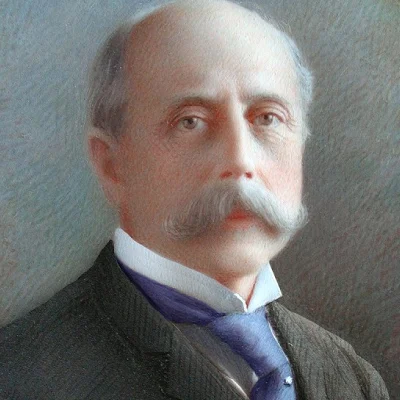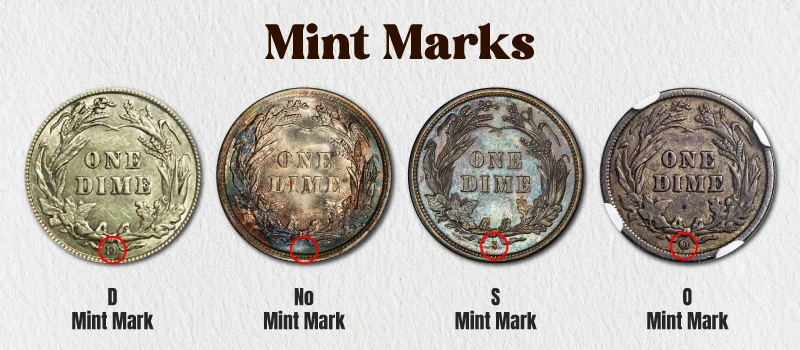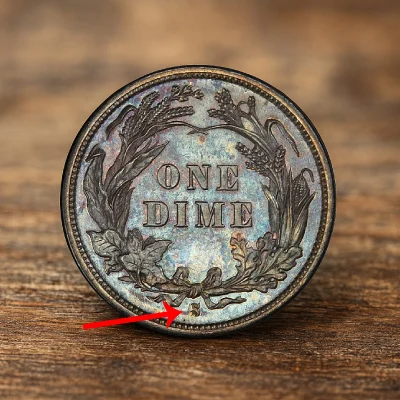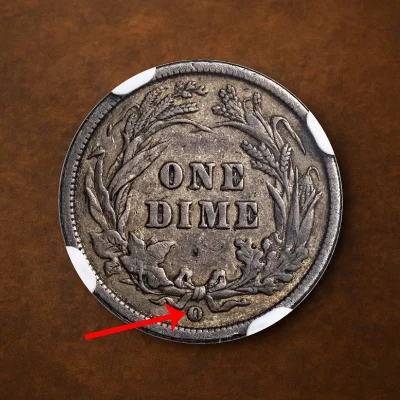
At first glance, a small silver coin from over a century ago might not turn many heads. Yet, to numismatists and sharp-eyed enthusiasts, Barber dimes present an intriguing story of American history and craftsmanship, often revealing far more than their humble denomination might suggest.
Issued between 1892 and 1916, these coins bear the name of their designer, Charles E. Barber, the Chief Engraver of the United States Mint at the time. The obverse side features the words 'United States of America' surrounding the depiction of Liberty, highlighting the connection between the coin's imagery and its representation of the country. Barber dimes represent a bridge between the stately coinage of the 19th century and the emerging artistry of the 20th. With their vivid Liberty head design and robust silver content, they captivate collectors seeking both historical context and tangible value.

The Barber coinage series, designed by Charles E. Barber, consists of a dime, quarter, and half dollar. These silver coins were minted from 1892 to 1916 and feature Liberty as the main design element. The series was a significant part of American numismatic history, replacing the Seated Liberty design that had been used since the 1830s. The Barber coinage was authorized by Congress in 1891, and the new designs were approved by President Benjamin Harrison in November 1891.
Charles E. Barber, the Chief Engraver of the United States Mint, was tasked with creating a new design that would modernize American coinage. The result was a series of coins that combined classical elements with a distinctly American aesthetic. The obverse of each coin features a profile of Liberty wearing a Phrygian cap and a laurel wreath, symbolizing freedom and victory. The reverse design includes a heraldic eagle on the quarter and half dollar, while the dime features a simple wreath.
The Barber coinage series is not only a testament to the artistic skills of Charles Barber but also a reflection of the era’s economic and cultural shifts. Collectors today appreciate these coins for their historical significance and the craftsmanship that went into their creation.
The Barber dime series is a well-known collectible coin set among coin collectors. The series includes various dates, with some being more rare than others, such as the 1894-S dime made at the San Francisco Mint. The coins were made in large numbers, with many dates available for collectors. This series is famous for its special designs and historical importance, making it a highly sought-after series among collectors. The series was later replaced by new designs, including the Mercury dime, introduced in 1916.
Each Barber dime has the famous Liberty head design on the front, with the word “LIBERTY” written on her headband. The back shows a simple but elegant wreath around the words “ONE DIME.” This design stayed the same through the series, making it easy to recognize and a favorite among collectors.
These coins give an interesting look at the late 19th and early 20th centuries, a time of big change and growth in the United States. Collectors are drawn to these coins not just for their beauty but also for the stories they tell about America’s past. Whether you’re an experienced collector or a newcomer to coin collecting, the Barber dime series offers a rewarding and educational collecting experience.
Assigning a precise value to a Barber dime involves more than glancing at a date or a quick online search. A coin's condition is crucial in determining its value and potential. Values can fluctuate significantly, hinging on several interlocking aspects:
Rarity and Mintage
Condition (Grade)
Mint Mark
Popularity Among Collectors
Historical Context
Of course, collectors need to assess various details such as mintmarks and specific features to accurately determine the value of coins.
Not every Barber dime enjoys the same scarcity. Certain years and mint marks saw limited production, turning these coins into genuine treasures for hobbyists.
For example, the 1895-O dime—struck at the New Orleans Mint—had a mintage of only 440,000. Today, examples in excellent condition are rare and fetch lofty prices. Meanwhile, common dates like 1914 dime value from the Philadelphia Mint might have hundreds of thousands of surviving pieces in varying grades.
Condition, often called the “grade,” is the number one consideration for collectors when determining value. Collectors use a 70-point scale, where 1 indicates a heavily worn coin in circulated condition, and 70 is an impeccably preserved piece with no visible flaws under magnification.
Here’s a quick reference on grades and why they impact the barber dime value chart:
| Grade | Description | Visual Traits |
|---|---|---|
| G (Good) | Heavily circulated | Details are almost flat, most lettering readable, Liberty’s head outline visible |
| VG (Very Good) | Moderate wear | More detail in the headband and face visible, but major features still worn flat |
| F (Fine) | Light circulation | Wreath and headband details restored, average clarity |
| VF (Very Fine) | Light even wear | All features clear, minor wear on high points |
| EF/XF (Extremely Fine) | Minimal wear | Only slight softness on the highest points |
| AU (About Uncirculated) | Nearly mint | Only minor traces of wear on cheek or cap |
| MS (Mint State, 60–70) | Uncirculated | No wear at all, may have bag marks or luster |
In the 'Good' grade, most lettering is readable, but the letters in 'Liberty' may be faint or partially worn. Coins just one grade apart can differ dramatically in price, especially for key dates and rare mint marks.

The small letter beneath the wreath on the coin’s reverse tells you where the coin was minted:
No Mint Mark – Philadelphia
O – New Orleans
S – San Francisco
D – Denver (only in 1916)
Certain combinations of year and mint yield coins far scarcer than their counterparts. The Barber coinage included different denominations such as dimes, quarters, and half dollars, all sharing a common design.
Collector demand isn’t always logical. Some dates or mints catch the attention of more people, driving values up regardless of their mintage. The design of the Barber dimes has received mixed reviews from both artists and the public, indicating that opinions on the coin's aesthetic and cultural value vary significantly among different groups. The pursuit of a full set by date and mint mark is a primary goal for many, putting some specific years into perennial high demand. Certain coins are worth more money based on factors like their mint mark and condition, highlighting the importance of these elements in determining the overall value of the coin.
While many Barber dimes are accessible and affordable for collectors, several rare examples command respect and eye-popping prices at auction. Mint Director Edward O. Leech initiated a competition to redesign the silver coins, offering a cash prize to the winner. These are some coins collectors are always on the lookout for. However, the invited artists were reluctant to participate due to the stipulation that only the winner would receive a cash prize, leading to the eventual choice of Charles Barber to create the new designs.

No discussion of Barber dimes is complete without the 1894-S. Famously, only 24 were minted at the San Francisco Mint—and fewer than 10 are believed to exist today. Stories swirl about their origins, including rumors they were minted as gifts for bankers’ children. The obverse side of the coin features the bust of Liberty wearing a Phrygian cap and a laurel wreath, with the date appearing just below the bust. In high grades, one of these dimes sold for nearly $2 million.

Another legendary key date, the 1895-O, surfaced with just 440,000 struck. Well-worn examples can still push four figures, while sharp, mint-condition pieces are celebrated centerpieces in advanced collections. The valuation process for these coins involves examining their distinctive characteristics, such as date and mintmark, which ultimately influences their worth in cents and attracts collectors looking for rare or high-demand examples.
Here’s a checklist of Barber dimes that frequently draw attention and higher-than-average prices:
Collecting these dates requires patience and persistence, along with a willingness to pay a premium for authenticity and condition. The annual report provides comprehensive data about the quality and value of Barber dimes, offering historical insights and market trends for collectors.
Each Barber dime contains just over 0.072 troy ounces of pure silver. Although most collectible examples command a premium far above their metal value, heavily worn or damaged dimes will often trade hands based primarily on their silver content.
As of early 2024, with silver hovering around $23–$25 per ounce, the melt value for a common, well-worn Barber dime is just under $2. But anything with clear details or semi-key dates will attract extra interest. When you sell these coins, consider their silver content and current market demand to maximize your returns.
Barber dime values can change a lot based on market demand and supply. The value of a Barber dime depends on its condition, rarity, and key dates. Professional coin grading services like PCGS and NGC can help decide a coin’s market value. Grading is a strict process that looks at minor flaws or wear and tear, making sure the coin is real and has the stated silver content. Having a coin graded can increase its possible market value. The prices listed for Barber dimes can vary depending on the dealer, with some dealers offering higher prices for rare or high-quality coins.
The market for Barber dimes is active, with prices affected by things like collector interest, economic conditions, and the availability of specific dates and mint marks. Important dates, like the 1894-S and 1895-O, often get higher prices because of their rarity and historical importance. Even common dates can show noticeable value increases if they are in high grades or have special features.
Keeping up with market trends and regularly checking price guides can help collectors make smart choices. Whether you’re buying or selling, understanding the factors that affect Barber dime values is very important for getting the most from your investment.
Maybe you inherited a dusty coin album or found one in a jar at an estate sale. Are these coins potentially significant?
Start with these questions:
For many coins, value increases dramatically if they show crisp detail and few signs of handling. Key dates with even moderate wear can beat the market considerably.
When unsure, reputable coin dealers and third-party grading services (like PCGS, NGC, or ANACS) can confirm authenticity and assign a professional grade. The competition held by Mint Director Edward O. Leech to design new silver coinage discouraged participation among artists, as only the winner would receive a cash prize, leading to a lack of suitable entries and ultimately resulting in Charles Barber being assigned to create the new designs.
Every collector starts somewhere. When gathering Barber dimes, a well-structured plan pays dividends:
Define Your Goal: Do you want a full set by year and mint? Or are you after high-grade examples of less common years?
Prioritize Key Dates: Work towards acquiring rare years first, as these often increase in value and can be difficult to find in good condition.
Buy the Best You Can Afford: Higher-grade coins usually retain value better over time, especially for rare dates and mint marks.
Document Your Collection: Keep clear records of each coin’s origin, price, and grade.
Experienced collectors often recommend patience, especially since pricing can fluctuate and supply for tougher dates is limited. The Barber coinage series also includes quarters and half dollars, which were part of the Mint's efforts to redesign U.S. coinage between 1892 and 1916.
Investing in Barber dimes can be a profitable opportunity for collectors and coin experts. The value of Barber dimes has gone up over the years, making them a good investment choice. The scarcity of certain dates, like the 1895-O dime, can increase their value. Also, the silver content of Barber dimes makes them a valuable investment, as silver prices keep rising. Collectors can buy individual coins or full sets, depending on their budget and choices. It’s important to research and understand market trends and coin values before buying to make a successful investment.
Barber dimes offer a unique mix of historical importance and real value, making them a good choice for investors. The growing interest in precious metals as a protection against economic uncertainty has also raised the demand for silver coins like the Barber dime. By focusing on important dates and high-quality examples, investors can build a portfolio that not only keeps wealth safe but also has a chance to grow in value.
As with any investment, careful research is important. Learning about trusted dealers, grading standards, and staying updated on market trends can help investors make smart choices and avoid common mistakes. Whether you’re an experienced investor or new to coin collecting, Barber dimes offer a rewarding and potentially profitable investment opportunity.
As with any classic collectible, pitfalls abound. Some to watch for include:
Counterfeits – Rare dates, especially the 1894-S, are targets for forgery. Always buy key coins authenticated by a well-known grading service.
Cleaned Coins – “Improving” an old coin with abrasive cleaning can devastate its value. Most collectors prefer naturally aged surfaces, known as patina or “original skin.”
Overpaying for Condition – Take special care not to pay a premium for common dates in high grades unless they are truly exceptional specimens.
Don’t be afraid to ask for advice, research past auction results, or compare coins at a local coin show.
These coins once jangled through the pockets of factory workers, shopkeepers, and train conductors, busily fueling the American economy. Today, each one is a direct link to those dynamic decades.
Whether you regard them as historical artifacts, tangible silver investments, or simply collectible treasures, Barber dimes offer layers of interest and satisfaction. For new collectors, they present a challenge that is rewarding, educational, and at times, unexpectedly lucrative. Veteran numismatists often find they never truly lose their appreciation for the classic, symmetrical profile Charles Barber left behind.
You can buy the US Mint’s renowned silver coins like the American Eagles, Morgan Silver dollars, and others at 2-6% less than Top dealers. BOLD offers a wide range of rare collectibles, investment-grade bullion, and iconic coinage! Shop Now!